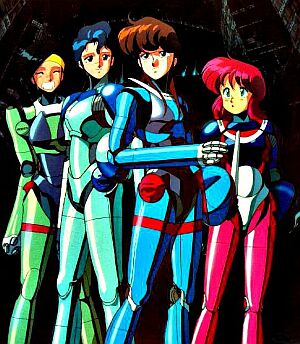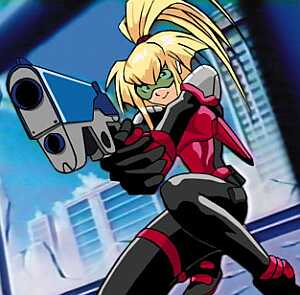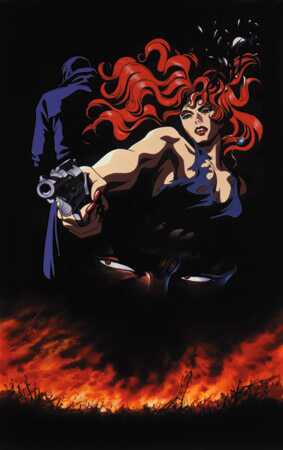★★
“Buffy goes East – and gets out of bed on the wrong side.”
 Don’t believe the running time: listed at 83 minutes on the DVD sleeve, this is actually under 50, a nasty piece of marketing to make you think you’re getting a full-length movie. Not sure whether an extra 25 minutes would help or harm here: there is certainly room for development, but equally, there is an awful lot of slack which seems designed only to show off whizzy digital animation. Saya is a vampire. She’s also a killer, tasked by…well, it’s never quite made clear who, but she hunts down bat-like monsters who can take human form. The only way to kill them is to make them lose a lot of blood. Very quickly. Being trapped forever in her teenage years, she’s ideally placed to go undercover at a school and investigate mysterious occurrences there.
Don’t believe the running time: listed at 83 minutes on the DVD sleeve, this is actually under 50, a nasty piece of marketing to make you think you’re getting a full-length movie. Not sure whether an extra 25 minutes would help or harm here: there is certainly room for development, but equally, there is an awful lot of slack which seems designed only to show off whizzy digital animation. Saya is a vampire. She’s also a killer, tasked by…well, it’s never quite made clear who, but she hunts down bat-like monsters who can take human form. The only way to kill them is to make them lose a lot of blood. Very quickly. Being trapped forever in her teenage years, she’s ideally placed to go undercover at a school and investigate mysterious occurrences there.
Set in 1966 for only one tangentially-connected reason, you’re never given enough information to care about Saya or any of the other characters. Mystery is one thing; obscurity another. She is perpetually pissed-off, which while initially appealing, does wear thin before long. I liked how some people spoke English, others Japanese, though this did have me fiddling with the DVD remote, since I thought I was watching a wretched dub. The Western characters seem horribly drawn; was this deliberate, or perhaps our faces just don’t suit anime style? As a standalone item, this is unsatisfying, despite some spectacular gore that will make you sit up and take notice. Give it another five episodes, and you could probably edit a decent feature out of this, but as it stands, it’s worth no more than a rental.
Dir: Hiroyuki Kitakubo
Star (voice): Youki Kudoh, Rebecca Forstadt, Joe Romersa





 Worthy of note as one of the first pieces of anime made available to an English-speaking audience, (not long after its original 1985 Japanese release), BGC is set in 2032, when Tokyo has been rebuilt, post-earthquake. The Genom corporation are fiddling with Boomers, biomechanical robots of immense strength but with a nasty tendency to run amok. Standing guard are a mysterious team, the Knight Sabers, with their own technological strengths, who alternate between merc work and more altruistic concerns.
Worthy of note as one of the first pieces of anime made available to an English-speaking audience, (not long after its original 1985 Japanese release), BGC is set in 2032, when Tokyo has been rebuilt, post-earthquake. The Genom corporation are fiddling with Boomers, biomechanical robots of immense strength but with a nasty tendency to run amok. Standing guard are a mysterious team, the Knight Sabers, with their own technological strengths, who alternate between merc work and more altruistic concerns. This teeters infuriatingly close to greatness, but eventually succumbs to mediocrity because of a tendency to juvenile smuttiness, that fatally weakens what is, at heart, an intriguing story and setting. The Warriors are a special police group – mostly female, with one token (lecherous) man – sent in to sort out nasty cases. The main thread in the four episodes here, is a virtual drug which can turn the consumer into a mind-controlled killer – or, presumably, anything else desired.
This teeters infuriatingly close to greatness, but eventually succumbs to mediocrity because of a tendency to juvenile smuttiness, that fatally weakens what is, at heart, an intriguing story and setting. The Warriors are a special police group – mostly female, with one token (lecherous) man – sent in to sort out nasty cases. The main thread in the four episodes here, is a virtual drug which can turn the consumer into a mind-controlled killer – or, presumably, anything else desired. Four stars but no seal of approval? That’s because this is about the most wildly variable animated film I’ve seen. The story and characters are great, but the frequent sex scenes are incredibly tedious and clearly put in solely for the teenage male fan (all pneumatic breasts and moaning). It’s rare for me to say this, but they are genuinely gratuitous, and the film could have coped fine without them.
Four stars but no seal of approval? That’s because this is about the most wildly variable animated film I’ve seen. The story and characters are great, but the frequent sex scenes are incredibly tedious and clearly put in solely for the teenage male fan (all pneumatic breasts and moaning). It’s rare for me to say this, but they are genuinely gratuitous, and the film could have coped fine without them.
 Watching this dubbed was, for once, viable since despite its Japanese origins, it’s firmly set in and around Chicago. So we did sit through some of it in English, but the accents were woefully Cal-girl and thus we’d recommend sticking with the Japanese, even more unlikely though it might be. That out of the way, this is an action-packed romp, in three episodes but effectively one story. Rally Vincent and May Hopkins, one a crack marksman, the other an explosives expert, own a gun store, but are blackmailed by the ATF into helping nail an arms ring. It’s not as simple as it seems, since the perps have connections at a high level, and the services of a former Soviet Special Forces hitwoman.
Watching this dubbed was, for once, viable since despite its Japanese origins, it’s firmly set in and around Chicago. So we did sit through some of it in English, but the accents were woefully Cal-girl and thus we’d recommend sticking with the Japanese, even more unlikely though it might be. That out of the way, this is an action-packed romp, in three episodes but effectively one story. Rally Vincent and May Hopkins, one a crack marksman, the other an explosives expert, own a gun store, but are blackmailed by the ATF into helping nail an arms ring. It’s not as simple as it seems, since the perps have connections at a high level, and the services of a former Soviet Special Forces hitwoman.